Werner Herzog & Klaus Kinski: Best of Enemies
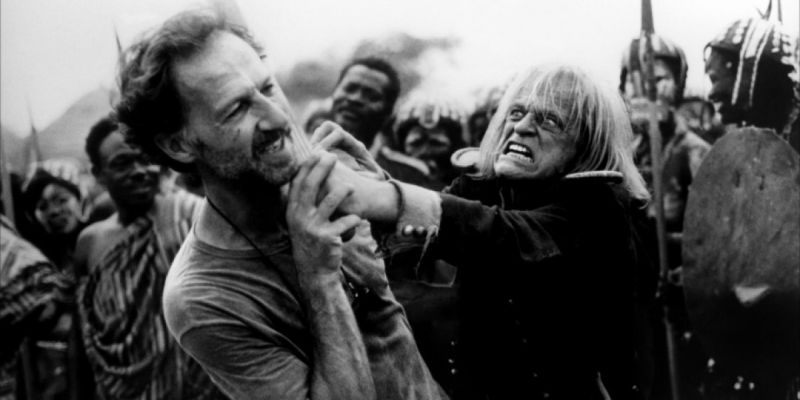
Has a soft spot for Hammer Horror films and is…
There have been an abundance of actor, actress and director collaborations throughout the history of cinema. One of the first collaborations in Hollywood was that of director D.W Griffth and actress Lilian Gish, who worked together on over thirty films throughout the 1910s and 1920s. Alfred Hitchc*ck collaborated with Cary Grant, Grace Kelly and James Steward several times throughout his career. Outside of Hollywood the Japanese duo of director Akira Kurosawa and Toshiro Mifune worked together on fifteen films throughout the years. Understanding, compromise and harmony are just some of the key ingredients that go into making a good working relationship.
When it comes to the pairing of the German duo of director Werner Herzog and actor Klaus Kinski, one would struggle to fathom why they worked together. Both men displayed a hatred for one another, which neither cared to hide while working together. While working together chaos ensued with tantrums, tyrannical demands and death threats. These scenes engulfed almost of their collaborations. Their toxic relationship brought everyone around them (including themselves) to the brink of insanity.
Can I Play With Madness?
Aguirre, the Wrath of God (1972) marks the first time that Herzog and Kinski collaborated and thus began the two’s infamously difficult relationship. The film tells the story of a group of Spanish conquistadors quest to find El Dorado in the South American jungle in 1560. The journey takes a turn for the worst when a solider Don Lope de Aguirre (Kinski) takes command of the expedition, and leads the group further into both the jungle and madness.
With a minimalist approach from director Herzog and the beautiful wild setting of the jungle, the film is a brilliant showcase of delirium and insanity. The character Aguirre will let nothing stand in his way in order to attain his goals and is driven insane trying to achieve them. Kinski’s portrayal of his character is utterly convincing and menacing; his physical appearance helps portray the insanity, with the actors big bug eyes bulging as he scourers the jungle landscape.
The film stands among Herzog’s best-known films and as such is one of his most influential pieces of work. The visual style of Aguirre had an immense impact on Francis Ford Coppola’s Apocalypse Now. Other films that have taken inspiration from Herzog’s work are The Mission, The New World and even Predator. The film is undoubtedly a masterpiece, but could have easily become a disaster due to the antics of its star.
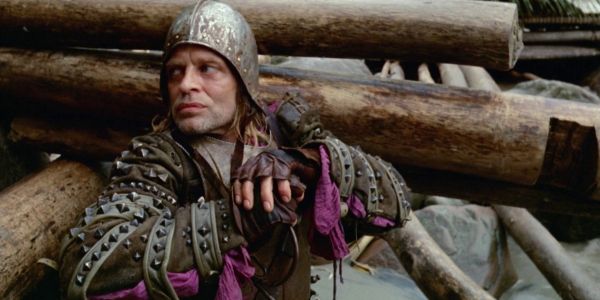
Kinski clashed with his director over how his character should be portrayed. Herzog wanted Aguirre to be more subtle and menacing, while Kinski wanted a wild, raving mad man. Due to not getting his own way, Kinski actually became the lunatic and delayed scenes from being shot. With his incoherent rants, he left the local natives (who were extras) terrified as he walked about the set shouting and attacking people. Herzog began to infuriate Kinski before scenes, knowing that the actor would tire himself out with his tantrums. As he would begin to tire, Herzog would roll the cameras and thus get the performance he wanted from his contrarian collaborator.
Kinski’s violent behaviour reached a new height, when in a rage at the noise coming from a tent beside his own, he took a pistol and fired three shots into the tent. This resulted in one of the film’s extras losing the tip of his finger. At one point Kinski threatened to leave the film set, which prompted Herzog to threaten the actor’s life. A legend has arisen that Herzog held Kinski at gun point and demanded that he complete the film, whose production was just as crazy as the events it depicts.
Nosferatu
It took over seven years for both Herzog and Kinski to work together again. After the experience of the first collaboration one would have thought that both men would never be able to be on the same set. Werner signed on to direct a remake of F.W Murnau‘s classic German Expressionist horror Nosferatu. Kinski was cast in the lead role as Count Dracula, as Herzog was able to use the original characters names due to Bram Stoker’s novel falling into the public domain (Murnau famously changed the characters names to avoid Stoker’s widowed wife suing the production). Even with the characters names and other details altered, Florence Stoker still took the production company to court.
The judge ruled in favour of the Stoker estate and ordered all copies of Nosferatu to be destroyed. Fortunately a copy of the film had already been circulated overseas for screening. Over the years the film was duplicated and rediscovered by a new audience. Herzog has stated that Murnau’s Nosferatu is the greatest German film ever made.
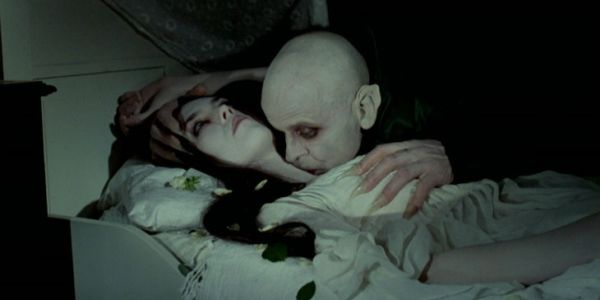
Nosferatu the Vamprye (1979) remains faithful to both Murnau’s original and Stoker’s novel. Jonathan Harker (Bruno Ganz) is sent by his employer to the castle of Count Dracula (Kinski) to complete a real estate deal; unbeknownst to Harker, the Count is a vampire. Upon seen a photo of Harkers’s wife Lucy (Isabelle Adjani), the count becomes obsessed with her. Count Dracula sets out to find Lucy after imprisoning Harker in his castle, and brings the black death to the small town where Lucy and Jonathan live.
Herzog manages to pay homage to the original and make the film his own at the same time. He recreates many of the Murnau‘s film’s famous scenes and does them justice. Never does it feel like a fan boy’s tribute to the source material, which instead becomes more of a visual reference for Herzog’s recreations. The film has some of the most eerie and unsettling scenes ever included in a vampire film.
Klaus Kinski’s performance as the Count is truly unsettling and at the same time heartbreaking. Although a reprehensible character, Kinski manages to bring a sense of pathos to the Count’s character. The Count at many times throughout the film describes the loneliness of being a vampire and how being immortal is a curse. The combination of the directing and Kinski’s performance results in one of the most chilling films centered on a vampire.
The clashes between Kinski and Herzog on the production of the film did not reach the dangerous heights of the ones on the set of Aguirre, but as with their previous collaboration both men fought about how the character was to be played. The film proved to be a critical hit and remains one of the duos most underrated work.
Woyzeck
Striking while the iron was hot, Herzog began production on his next film a week after Nosferatu wrapped. Choosing to use most of the cast and crew form his previous film, he began work on Woyzeck (1979), based upon the unfinished play by dramatist Georg Büchner.
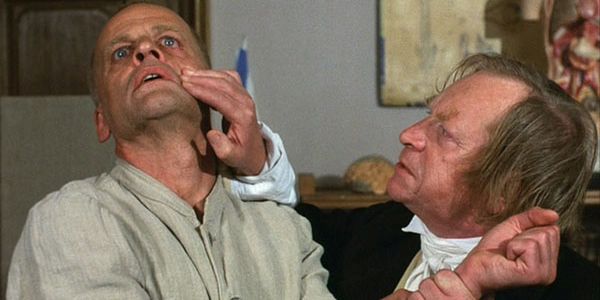
The plot follows Franz Woyzeck (Kinski) a lowly solider who is stationed in a small German town in the mid-nineteenth century. Woyzeck has fathered an illegitimate child with his mistress Maire (Eva Mattes), and takes to doing menial jobs in order to care for his family. As the film progresses Woyzeck’s mental health begins to deteriorate and leads to devastating consequences.
The decision to head straight into a new production clearly took its toll on both the cast and crew. The direction of Herzog is very static, which is compounded by his choice to utilize long takes throughout the film. The entire film was shot using only twenty-seven cuts and was completed in eighteen days. Kinski’s exhaustion from the previous shoot manifested itself in his character; apparently this is what Herzog wanted. The result is a character that is on breaking point and Kinski performs this very well indeed.
Woyzeck as a whole can feel lethargic as the long takes begin to feel a bit stale as the film progresses, but it’s held together by Kinski and Mattes in the lead roles. Herzog and Kinski by all accounts got along fine during the making of this film. With an eighteen day shoot, both men did not have time to get under one another’s skin. While certainly not their best effort, Woyzeck does hold a certain charm and is well worth the watch.
The Burden of the Dream
It is impossible to imagine Fitzcarraldo (1982) without Klaus Kinski, but that was the case when Herzog began production on the film. He decided against casting Kinski because he thought the actor would become uncontrollable in the jungle while shooting the film. Instead he opted to cast Jason Robards in the lead role of would-be rubber baron Brian Sweeney Fitzgerald. For the role of Fitzgerald’s assistant Wilbur, Herzog cast Rolling Stones front man Mick Jagger.
The surreal adventure follows Brian Fitzgerald Sweeney’s plans to build an opera house in the middle of the South American jungle in the early 20th Century. Fitzgerald is a dreamer who already has major business failures behind him, but his indomitable spirit never fails. He comes up with the plan to fund his opera house by exploiting the abundance of rubber trees in the jungle around the outpost in which he lives. This sets in motion a Quixotic journey in which a man attempts to conquer nature.
Robards completed forty percent of his part until he fell ill with dysentery calling a halt to production. Robards left the jungle to seek treatment, his doctor advised him not to return to the set to complete the film. As production was on hold, Mick Jagger’s shooting schedule expired and thus had to leave the set to go on tour with the Rolling Stones. What was merely a difficult shoot in the jungle now became a nightmare as Herzog lost both of his leading men. After much deliberation, Herzog cast Kinski in the role of Fitzgerald, and due to Jagger’s exit cut the character of Wilbur. The director then altered parts of the script and restarted the film from scratch with Kinski, by the end of the production both men would be brought to breaking point.
Kinski’s arrival only exasperated tensions that were already high on the set, caused by the grueling heat and the difficultly of shooting in the jungle. Herzog’s relationship with the local Machiguenga tribe (who were extras and crew members) soured and caused much grief for the director. At one point the set was attacked by a rival tribe looking for food, leaving one of the crew with a neck wound from a spear. Kinski didn’t help with his raving antics and left the extras frightened of him. Herzog has said that one of the tribal chiefs offered to kill Kinski due to his deranged antics, but he declined as he wanted to complete the film.
Many film critics have noted how Fitzgerald’s behavior mirrors that of Werner Herzog. The film’s most iconic scene is when Fitzgerald is compelled to haul his steam boat over a mountain by the help by the native tribe which he has convinced to aid him in this seemingly impossible charge. Herzog refused to use special effects and had the locals pull the boat over the mountain with a complex systems of pullies. The dangers of this act do not need to be stated, Herzog’s tyrannical demands endangered the lives of many.
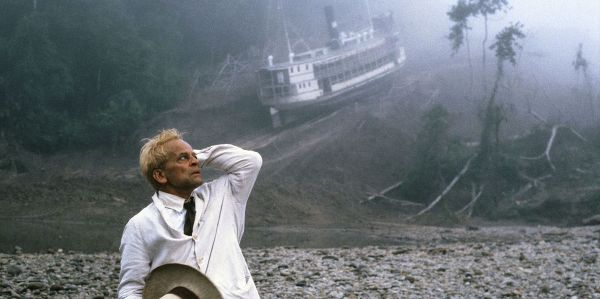
Documentary film maker Les Blank was on set filming a documentary about the making of the production. His film Burden of Dreams captures many of the insane moments that occurred on the set. Blank also gives an insight into the toxic and dangerous relationship between Herzog and Kinski. Blank claims in his documentary that he witnessed Kinski physically attacking one of Herzog’s deputies on the set. Blank and his crew contrasted the experience to that of a solider coming home from war when talking about their experience on the set.
Just like Aguirre, Fitzcarraldo has been hailed as a masterpiece by many film critics. The film reaches the dizzying heights of their first collaboration and many fans would argue that it’s Herzog‘s magnum opus. Kinski is brilliant as the incompetent yet likeable would-be rubber baron, trying to fulfill his dream. The film has many surreal moments, characteristic in Herzog’s work, and is a prime example of the common trope found in cinema; man verse nature, a theme with which Herzog would continue to wrestle throughout his career.
The End
Cobra Verde (1987) would mark the last time that Klaus Kinski and Werner Herzog would work together. The film tells the tale of Francisco Manoel da Silva a.k.a Cobra Verde (Kinski), a man who becomes a notorious outlaw after killing his boss, taking the name Cobra Verde. da Silva becomes involved with a sugar baron Don Octávio Coutinho (José Lewgoy), who witnesses his skills at subduing an escaped slave. After employing da Silva on his plantation, Coutinho discovers that his three daughters have been impregnated by Cobra Verde. As punishment da Silva is sent to Africa on an impossible mission to re-open Brazil’s slave trade. While in Africa da Silva plots his revenge as he descends into madness.
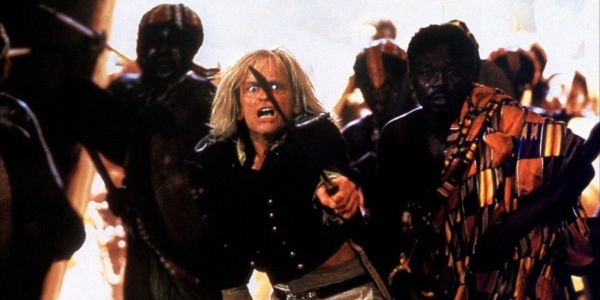
On the set of Cobra Verde, Kinski’s torrent of abuse to cinematographer Thomas Mauch caused him to walk of the set. Herzog had to find a replacement and hired Viktor Růžičkaand. Tensions between Herzog and Kinski reached fever pitch as their relationship broke down. Both men refused to talk to one another and this clearly had an affect of the quality of the film. Kinski had become so difficult to work with that Herzog vowed never to work with him again once production wrapped up.
The film never quite reaches its potential and at times the plot becomes confusing. Kinski’s performance is brilliant at times, glistening in the sweltering heat of west Africa. Herzog’s approach to the film is dark and surreal just like much of his other work. Overall the film just feels a bit off and never quite comes together, but as devout Herzog fan Roger Ebert once wrote about the director’s work, he “has never created a single film that is compromised, shameful, made for pragmatic reasons or uninteresting. Even his failures are spectacular”.
Conclusion
To answer the question about why both men continued to work with each other, Herzog released a documentary entitled My Best Fiend (1999). The documentary explores the volatile relationship between both men, with Herzog giving a frank insight into the turmoil that their collaboration created. While Herzog does not shy away from the fact that Kinski was almost impossible to work with, he also shows deep respect for the actor, expressing an immense respect for Kinski and recognizing his talent. Two actresses who worked with Kinski on Herzog films, Eva Mattes and Claudia Cardinale tell Herzog that there was a very calm sided to Kinski. The last shot of the documentary shows a joyful Kinski playing with a butterfly in the South American jungle.
Klaus Kinski died of a heart attack in November 1991 at the age of 65, ending any chances of him and Herzog working together again. While the relationship between the two men has become notorious, each time they collaborated they created an intriguing piece of work. Both men brought out the best in each other when it came to their craft. Kinski’s filmography is hit and miss to say the least; his stand out films are those with Herzog. On the other hand Herzog has had a very successful career as a director of short films, documentary and feature-length films, although his most well renowned are those starring Kinski.
Is there any other actor/actress and director collaboration that is as insane yet brilliant as Werner Herzog and Klaus Kinski?
Does content like this matter to you?
Become a Member and support film journalism. Unlock access to all of Film Inquiry`s great articles. Join a community of like-minded readers who are passionate about cinema - get access to our private members Network, give back to independent filmmakers, and more.
Has a soft spot for Hammer Horror films and is constantly looking to further his knowledge of cinema.












